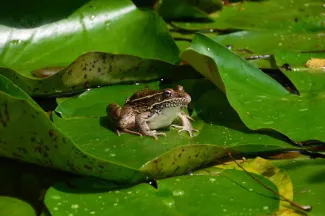After the dog days of summer and the recent memories of colorful blossoms, many Oklahomans are taking advantage of fall’s cooler weather to redesign their backyard landscape. Wildlife enthusiasts can take their landscaping plans one step further by adding plants and features that will attract wildlife to their own property. The practice of landscaping with wildlife in mind is often referred to as “wildscaping” and is a great way for backyard naturalists to contribute to conservation efforts.
The most productive wildscape contains each of the major habitat components for wildlife: food, water and cover. The ideal plan uses natural vegetation to supply food all year – from the earliest summer berries to fruits that persist through winter and spring. A source of clean, dependable water year-round is another necessity. When food and water are in close proximity to protective cover, your wildscape will be even more attractive to animals, especially migrating birds in the spring and fall.
To help get your wildscape started, the Wildlife Diversity Program would like to offer the following considerations for your design.
Plotting Your Design
Before any work begins, you first need to set guidelines for your wildscape. Which species of wildlife would you like to attract? How much space can you allot? How much time can you dedicate to maintaining the wildscape? What is a realistic budget for your project? You’ll also need to consider an city ordinances before creating a wildscape .
While habitat needs of many wildlife species overlap, you may only want to entice a few species to your space. For example, if you are primarily interested in attracting butterflies, a smaller wildscape filled with nectar-producing plants may do the trick. If you want to lure more frogs or other amphibians, a water feature may be all that is needed. But attracting more species of birds or increasing the overall diversity of wildlife on your property may require more space, more food plants and more cover plants. After your target wildlife species are selected, you can identify which habitat components may be limiting in your current landscape.

When compared to a manicured yard, a well-established wildscape typically requires less maintenance. Even so, newly planted flowers, grasses and shrubs need to be regularly watered. They may also need to be protected from aggressive plants like bermudagrass or johnsongrass. Large or small, wildscapes take time and money to become successful.
Once you’ve set your wildscape goals, take an inventory of the plants and special features already in your yard. This list can then be used as a foundation to build upon and plans can be made to fill in any habitat needs. For example, multiple layers of overlapping trees and shrubs can be planted around the edges of your wildscape if protective cover is limiting. Wildflowers and fruiting plants can be added to provide wildlife additional food, and nesting boxes and wildlife feeders can be installed to supplement natural habitat.
Planting Your Design
More than 2,000 native plants have been identified in Oklahoma and many of those plants can be brought into your backyard landscape. Choosing plants from your surrounding ecoregion is a great option as they are well-adapted to your area’s temperatures and rainfall amounts. Your favorite flowers and colors can also be incorporated in to the landscape to bring added enjoyment, but consider plants that provide two or more positive wildlife features if you have a smaller wildscape. The following 25 plants can add splashes of color to your backyard while attracting a number of butterflies and songbirds. Get more plant ideas for your wildscape in Patricia Folley’s “The Guide to Oklahoma Wildflowers.”
Plants that Provide Food | ||
| To Attract Butterflies | Bee Balm | Milkweeds *Host plant for monarchs |
| Blazing Star | Passionvine *Host plant for gulf fritillary | |
| Purple Coneflower | Indian Paintbrush *Host plant for common buckeye | |
| Buttonbush | Chokecherry Tree *Host plant for eastern tiger swallowtail | |
| Goldenrod | False Indigo | |
| To Attract Hummingbirds | Salvia | Fire Pink |
| Coral Honeysuckle | Coral Bells | |
| Trumpet Creeper | ||
| To Attract Songbirds | Annual Sunflower | Huckleberry |
| Deciduous Holly | American Beautyberry | |
| Illinois Bundleflower | ||
Plants that Provide Cover | ||
| American Holly | Carolina Cherry Laurel | |
| Sand Plum | Yaupon Holly | |
| Oklahoma Blackberry | ||
Adding Features to Your Design
In addition to planting trees, shrubs and flowers, you can enhance your wildscape with man-made creations. Building natural structures like brush piles or wood piles is an easy way to temporarily improve your wildscapes cover options. Songbirds will readily perch on the brush pile limbs while rabbits and turtles can escape underneath the branches. Flowing water features or bird baths not only quench the thirst of visiting birds, but also attract insects which are an important food source for many species. A small butterfly “puddle,” nesting boxes or even an artificial burrow for toads can help attract more wildlife to your property.
Get more tips for turning your backyard into a wildlife oasis in “Landscaping for Wildlife: A Guide to the Southern Great Plains.” This book provides ample wildscape plans; extensive plant lists; project ideas for your family; and designs for nest boxes and feeders.